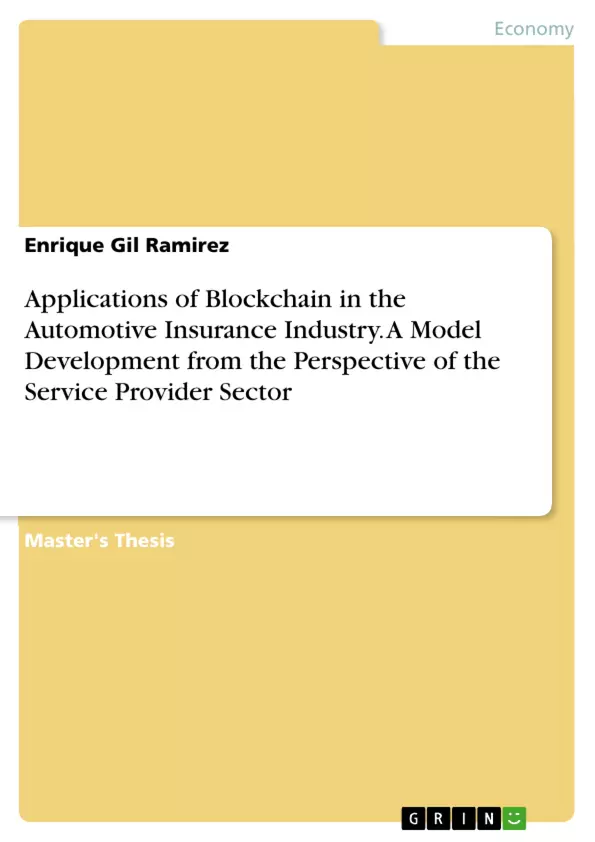This research has been gathered together with the collaboration of Control Expert Company, a German company dedicated to providing services to the core business of the automotive insurance industry. This research is mainly focused on the different applications that Blockchain technology offers the automotive insurance industry. Based on these applications, a process model is developed from the perspective of the service provider sector of the automotive insurance. Having the main focus in mind, this research will answer the following question: How does Blockchain technology benefit the Automotive Insurance Process?
The structure of this research will lead the reader through the evolution of the Blockchain technology and its features. First, a full definition of the technology will be explained. This will be followed by the generations of Blockchain and its classification. After that some history on regards Blockchain and the digital era will be mentioned. Such as the main innovations of the digital era, the creators of the technologies involved in Blockchain, and the main innovations within Blockchain.
As the Internet of Things has become more and more popular during the last years, it is not possible to ignore the huge impact that it is having on people's daily lives. IoT represents a network of devices such as sensors, vehicles, computers and more, which interact among themselves and exchange information. Here comes a very interesting subcategory of the IoT – The Internet of People. The Internet of People describes the exchange of data through different devices but related to the people, or, in other words, the information gathered comes strictly from people.
From this idea, the Internet of Money rises describing mainly how Blockchain and Bitcoin are changing the financial system. This is based on the idea of recording transactions in a safer way within a more decentralized system. Due to the strong disruption of Blockchain within different industries and the usability of the technology, it has been considered as an extra layer working over the internet. This is a new tier that enables transactions on a different level; permitting storage and record of data in a different way than a conventional database.
Inhaltsverzeichnis (Table of Contents)
- 1. Introduction
- 2. Origin and Definition of Blockchain
- 3. Blockchain 1.0
- 4. Blockchain 2.0
- 4.1 Smart Contracts
- 5. Blockchain 3.0
- 6. Blockchain in the Industries
- 6.1 State of the Art of Blockchain in the Insurance Industry
- 6.2 Service Providers Sector for the Automobile Insurance Industry (Control Expert example)
- 7. Research Methodology
- 7.1 Research Design
- 7.2 Research Sample
- 7.3 Data Collection
- 7.4 Data Analysis
- 7.5 Limitations
- 8. Model Industry Using Blockchain
- 8.1 Architecture of the Automated Vehicle Crash Model
- 8.2 Finite State Machine
- 8.3 Blockchain Process Model
Zielsetzung und Themenschwerpunkte (Objectives and Key Themes)
This master's thesis investigates the applications of blockchain technology within the automotive insurance industry, focusing on the perspective of service providers. The primary research question is: How does blockchain technology benefit the automotive insurance process? The study explores the potential of blockchain to enhance efficiency and reduce costs by automating processes and eliminating intermediaries.
- Evolution and functionalities of blockchain technology.
- Applications of blockchain in various industries, with a focus on insurance.
- Development of a process model for automated vehicle crash claims using blockchain.
- Integration of telematics data with blockchain for improved risk assessment and claim processing.
- Analysis of the advantages and disadvantages of blockchain implementation in the automotive insurance sector.
Zusammenfassung der Kapitel (Chapter Summaries)
Chapter 1: Introduction introduces the research topic, highlighting the impact of the Internet of Things and the rise of blockchain technology in the financial system. It establishes the research question and outlines the thesis structure.
Chapter 2: Origin and Definition of Blockchain provides a comprehensive overview of blockchain technology, its definition from both technical and business perspectives, and its various classifications. It distinguishes between Blockchain and Bitcoin and explores the history and key innovations related to blockchain.
Chapter 3: Blockchain 1.0 details the characteristics of the first generation of blockchain technology, as exemplified by Bitcoin. It explains the structure, elements, and functionalities of blockchain 1.0, including its advantages and disadvantages from both technical and non-technical standpoints.
Chapter 4: Blockchain 2.0 discusses the second generation of blockchain, focusing on smart contracts. This chapter analyzes the attributes of innovation and the rate of adoption for blockchain technologies and explores the concept of smart contracts, including their advantages, disadvantages, and implementation through platforms like Ethereum.
Chapter 5: Blockchain 3.0 delves into decentralized applications (Dapps) and their role in the third generation of blockchain. It addresses issues of scalability, interoperability, and sustainability, along with the relationship between Dapps and smart contracts.
Chapter 6: Blockchain in the Industries explores the application of blockchain across various industries, emphasizing its potential within the insurance sector. This chapter presents statistical data on blockchain adoption and discusses case studies of companies implementing blockchain technology in the insurance industry, including Control Expert's role in the automotive insurance sector.
Chapter 7: Research Methodology outlines the research design, sample selection, data collection, and data analysis methods employed in the study. It addresses the limitations of the research and explains the rationale behind using a case study approach, a conceptual design, and qualitative data analysis.
Chapter 8: Model Industry Using Blockchain presents the proposed model for automated vehicle crash claims using blockchain. This chapter describes the architecture of the model, using a finite state machine to illustrate the process flow, and explains the implementation process through a series of diagrams.
Schlüsselwörter (Keywords)
Blockchain technology, automotive insurance, service providers, smart contracts, decentralized applications (Dapps), telematics, Internet of Things (IoT), risk assessment, claim processing, process automation, Control Expert, Ethereum, distributed ledger technology, cryptocurrency, insurance telematics, usage-based insurance (UBI), pay-as-you-drive (PAYD), pay-how-you-drive (PHYD).
- Quote paper
- Enrique Gil Ramirez (Author), 2018, Applications of Blockchain in the Automotive Insurance Industry. A Model Development from the Perspective of the Service Provider Sector, Munich, GRIN Verlag, https://www.grin.com/document/926111



